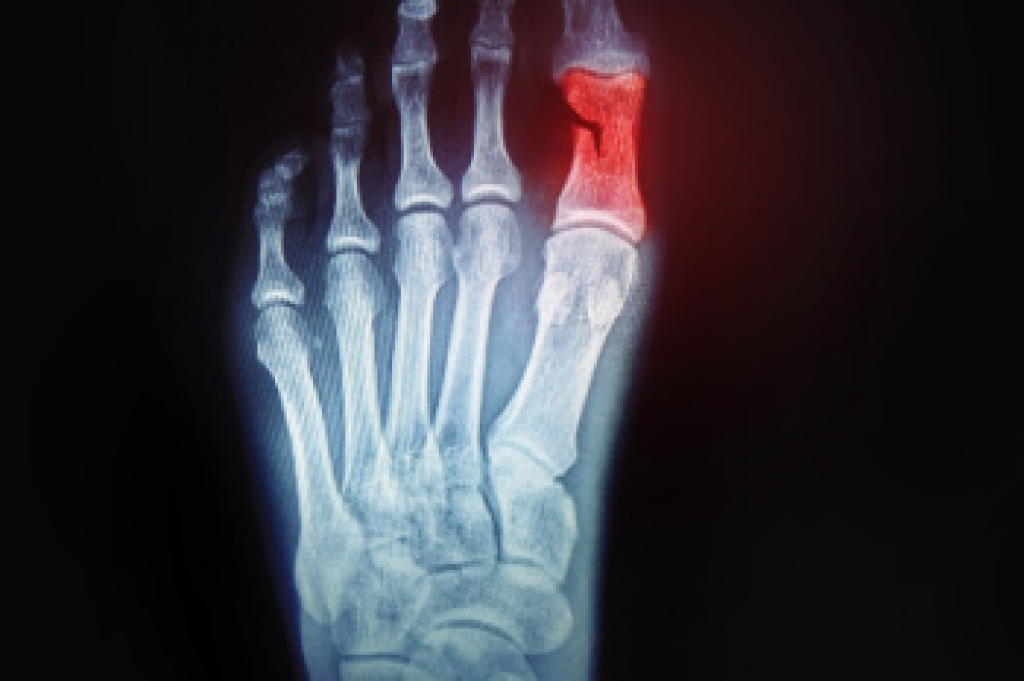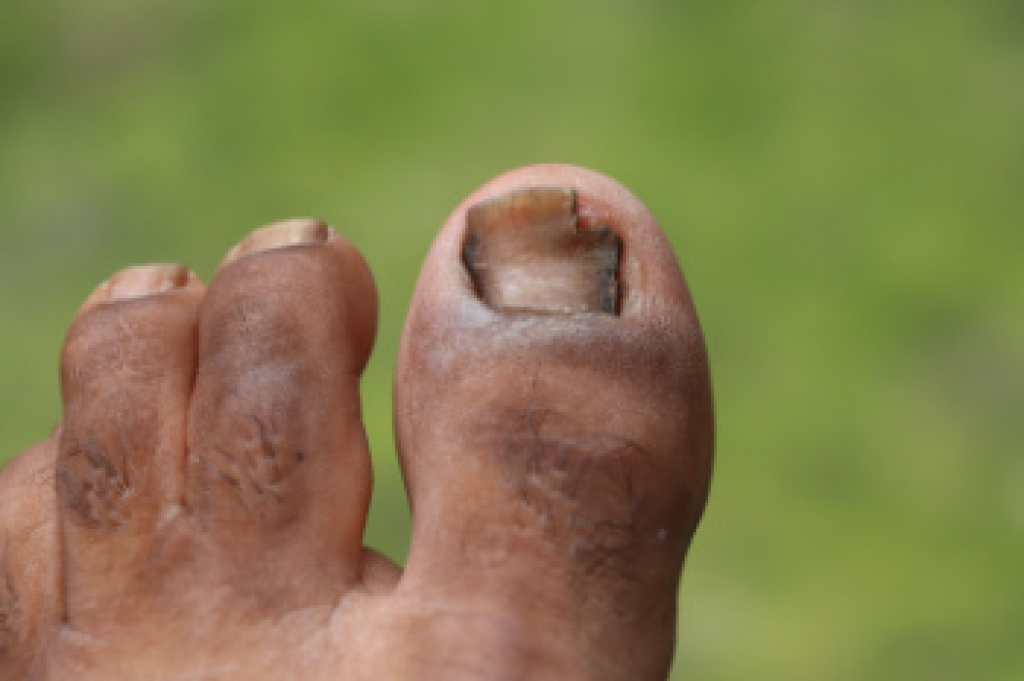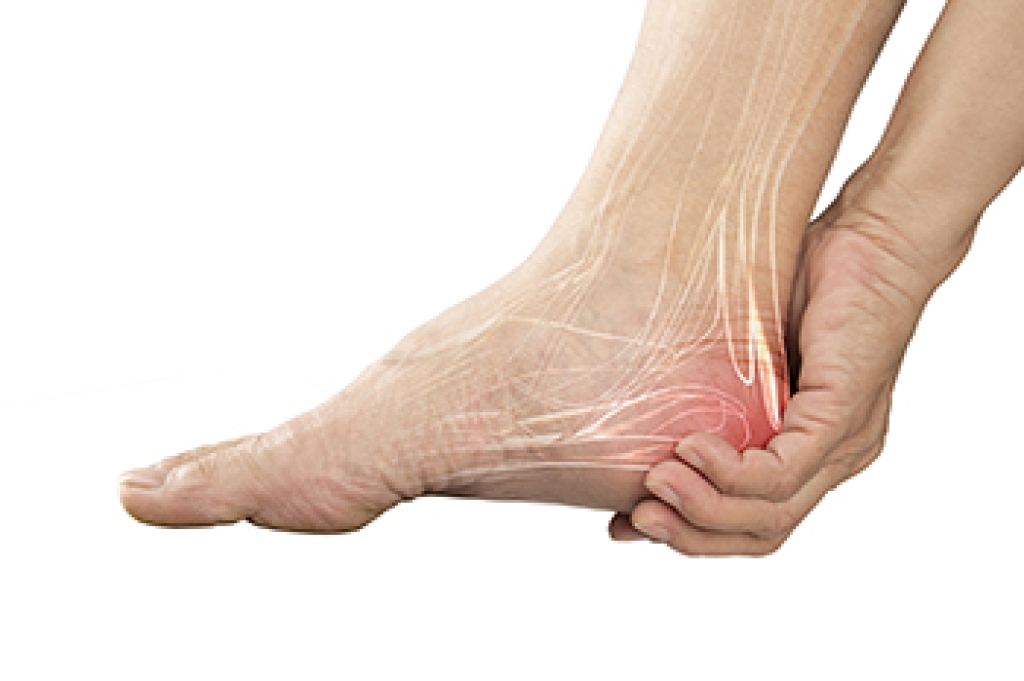Blog
Causes and Treatment of a Broken Toe

A broken toe can occur from dropping something heavy on the foot, stubbing the toe with force, or sustaining repetitive stress during activities. Symptoms of a broken toe include swelling, bruising, pain while walking, and sometimes a visible deformity if the bone has shifted out of place. A podiatrist can examine the injured toe and may use an X-ray to confirm the fracture and to determine its severity. Treatment may involve stabilizing the toe with a stiff-soled shoe, protective boot, or cast to reduce movement and promote healing. In cases where the bones are displaced, realignment may be required, and severe fractures may need surgery with pins or other fixation devices to restore proper position. Healing generally takes several weeks, and without care, complications such as chronic pain or arthritis in the toe joint may develop. If you have broken a toe, it is suggested that you make an appointment with a podiatrist for an exam, diagnosis, and appropriate treatment.
A broken toe can be very painful and lead to complications if not properly fixed. If you have any concerns about your feet, contact one of our podiatrists from Geller Foot Clinic. Our doctors will treat your foot and ankle needs.
What to Know About a Broken Toe
Although most people try to avoid foot trauma such as banging, stubbing, or dropping heavy objects on their feet, the unfortunate fact is that it is a common occurrence. Given the fact that toes are positioned in front of the feet, they typically sustain the brunt of such trauma. When trauma occurs to a toe, the result can be a painful break (fracture).
Symptoms of a Broken Toe
- Throbbing pain
- Swelling
- Bruising on the skin and toenail
- The inability to move the toe
- Toe appears crooked or disfigured
- Tingling or numbness in the toe
Generally, it is best to stay off of the injured toe with the affected foot elevated.
Severe toe fractures may be treated with a splint, cast, and in some cases, minor surgery. Due to its position and the pressure it endures with daily activity, future complications can occur if the big toe is not properly treated.
If you have any questions, please feel free to contact our office located in Lathrup Village, MI . We offer the newest diagnostic and treatment technologies for all your foot care needs.
When Toenails Fall Victim to Fungi

A fungal toenail infection often begins subtly, with a small white or yellow spot beneath the nail. Over time, the infection can spread deeper, causing the nail to thicken, become brittle, and change color. The surface may turn rough or crumbly, and, in some cases, the nail can lift away from the bed entirely. Warm, moist environments like sweaty shoes create the perfect setting for fungi to thrive, which is why this condition is common among athletes and older adults. Although not usually painful in the early stages, the infection can become uncomfortable and make walking or wearing shoes difficult. Mild remedies rarely provide a lasting cure, and untreated infections often persist for years. For safe and effective solutions tailored to your needs, it is suggested that you see a podiatrist for evaluation and appropriate treatment, which may include prescribed medication.
For more information about treatment, contact one of our podiatrists of Geller Foot Clinic. Our doctors can provide the care you need to keep you pain-free and on your feet.
Toenail Fungus Treatment
Toenail fungus is a condition that affects many people and can be especially hard to get rid of. Fortunately, there are several methods to go about treating and avoiding it.
Antifungals & Deterrence
Oral antifungal medicine has been shown to be effective in many cases. It is important to consult with a podiatrist to determine the proper regiment for you, or potentially explore other options.
Applying foot powder on the feet and shoes helps keep the feet free of moisture and sweat.
Sandals or open toed shoes – Wearing these will allow air movement and help keep feet dry. They also expose your feet to light, which fungus cannot tolerate. Socks with moisture wicking material also help as well.
If you have any questions please contact our office located in Lathrup Village, MI . We offer the newest diagnostic and treatment technologies for all your foot and ankle needs.
Arthritis That Can Take a Toll on the Ankles

The ankle joint carries the body’s weight with every step, making it vulnerable when arthritis sets in. One common type is osteoarthritis, which develops gradually as cartilage wears down over time, leading to stiffness and pain. Rheumatoid arthritis is another, caused by the immune system attacking the joint lining, often affecting both ankles at once and causing swelling and deformity. Post-traumatic arthritis can appear years after an ankle injury, such as a fracture or severe sprain, as damaged cartilage breaks down earlier than normal. Less commonly, gout targets the ankle when uric acid crystals build up, triggering sudden, sharp pain and redness. Each form of arthritis may affect the ankle differently, but all can reduce mobility and interfere with daily life. If you have any kind of ankle pain, it is suggested that you schedule an appointment with a podiatrist for a proper diagnosis and appropriate care.
Arthritis can be a difficult condition to live with. If you are seeking treatment, contact one of our podiatrists from Geller Foot Clinic. Our doctors can provide the care you need to keep you pain-free and on your feet.
Arthritic Foot Care
Arthritis is a joint disorder that involves the inflammation of different joints in your body, such as those in your feet. Arthritis is often caused by a degenerative joint disease and causes mild to severe pain in all affected areas. In addition to this, swelling and stiffness in the affected joints can also be a common symptom of arthritis.
In many cases, wearing ill-fitting shoes can worsen the effects and pain of arthritis. Wearing shoes that have a lower heel and extra room can help your feet feel more comfortable. In cases of rheumatoid arthritis, the arch in your foot may become problematic. Buying shoes with proper arch support that contour to your feet can help immensely.
Alleviating Arthritic Pain
- Exercises that stretch the foot can prevent further pain and injury and increase mobility
- Most of the pain can be alleviated with anti-inflammatory drugs, heat, and topical medications
- Massages can help temporarily alleviate pain.
It is best to see your doctor for the treatment that is right for your needs and symptoms. Conditions vary, and a podiatrist can help you determine the right method of care for your feet.
If you have any questions please feel free to contact our office located in Lathrup Village, MI . We offer the newest diagnostic tools and technology to treat your foot and ankle needs.
The Hidden Bursa Behind Your Heel

Retrocalcaneal bursitis is a painful condition that affects the small fluid-filled sac located between the heel bone and the Achilles tendon. This bursa helps reduce friction, but when it becomes inflamed, every step can feel uncomfortable. The pain is usually felt at the back of the heel, especially when walking, running, or wearing tight shoes that put pressure on the area. Swelling, tenderness, and stiffness surrounding the heel are also common signs. The condition often develops from overuse, repetitive stress, or footwear that irritates the heel. Athletes and individuals who spend long hours on their feet may be more prone to bursitis. Treatment may involve rest, heel lifts, or changes in footwear to reduce pressure on the tendon and bursa. If pain persists, it is suggested that you see a podiatrist who can provide custom orthotics, targeted exercise, or other advanced treatments to restore comfort.
Many people suffer from bouts of heel pain. For more information, contact one of our podiatrists of Geller Foot Clinic. Our doctors can provide the care you need to keep you pain-free and on your feet.
Causes of Heel Pain
Heel pain is often associated with plantar fasciitis. The plantar fascia is a band of tissues that extends along the bottom of the foot. A rip or tear in this ligament can cause inflammation of the tissue.
Achilles tendonitis is another cause of heel pain. Inflammation of the Achilles tendon will cause pain from fractures and muscle tearing. Lack of flexibility is also another symptom.
Heel spurs are another cause of pain. When the tissues of the plantar fascia undergo a great deal of stress, it can lead to ligament separation from the heel bone, causing heel spurs.
Why Might Heel Pain Occur?
- Wearing ill-fitting shoes
- Wearing non-supportive shoes
- Weight change
- Excessive running
Treatments
Heel pain should be treated as soon as possible for immediate results. Keeping your feet in a stress-free environment will help. If you suffer from Achilles tendonitis or plantar fasciitis, applying ice will reduce the swelling. Stretching before an exercise like running will help the muscles. Using all these tips will help make heel pain a condition of the past.
If you have any questions, please feel free to contact our office located in Lathrup Village, MI . We offer the newest diagnostic and treatment technologies for all your foot care needs.

